I sure hope you didn’t listen to the nervous Nellies who told you to pull your cash out of stocks ahead of the election. Since October 30, the S&P 500 has jumped more than 5%, as of this writing.
And remember tech stocks, the sector everyone seemed to be leaving for dead a few days ago? They’re up nearly 7%, going by the tech benchmark Invesco QQQ Trust (QQQ).
2020 Pulls a Fast One on Panic Sellers (Again!)
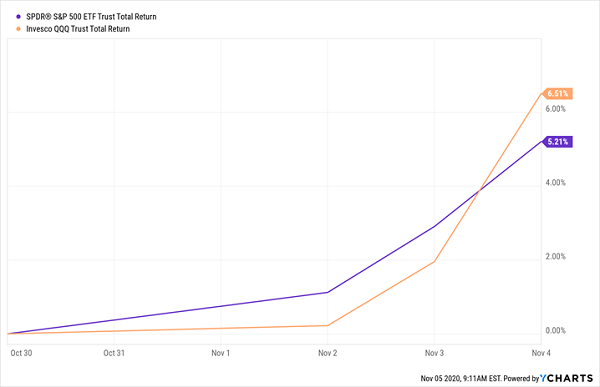
This is particularly painful if you’re a dividend investor. If you sold just a few days ago, you’re now forced to buy back in at higher prices—and lower yields! (This, by the way, is why my colleague Brett Owens and I have been pounding the table on unloved tech stocks in recent days. If you’ve followed our advice, you’re doing great.)
With the great deal on QQQ is now a thing of the past, we need to take a different route if we want to get back into tech now (or, if you held on through the last few days, amp up your tech gains—and dividends).
Luckily there’s an investment that lets us buy top tech names at October’s prices—and boost our dividends 5X (and maybe more!), too: closed-end funds (CEFs).
The Discount “Hack” in CEFs
If you buy QQQ, you’re getting an exchange-traded fund (ETF) that holds the 100 stocks in the index the fund tracks, which is skewed toward tech and includes the big FAANG players you know well: Facebook (FB), Amazon (AMZN), Apple (AAPL), Netflix (NFLX) and Google (GOOG, GOOGL) among them. But if you buy a dollar of QQQ, you’re getting a dollar of these stocks—ETFs trade pretty much exactly at the underlying value of the stocks they hold.
CEFs are different. There are far fewer of them (the CEF market is about 7% the size of the ETF universe), so they are often overlooked. But CEFs have a big following among savvy investors who know of their underlying value, especially when it comes to the relationship between a CEF’s NAV and its market price.
Don’t get too hung up on the jargon here; it’s really quite simple. CEFs have a more or less fixed number of shares, while ETF issuers can release new shares of their funds pretty well any time. This means a CEF’s shares can rise even if the actual value of its portfolio (its net asset value, or NAV) stays the same. In such a case, the market price can go higher than the NAV, making the CEF trade at a premium.
Premiums can be huge. Check out the PIMCO Corporate & Income Opportunities Fund (PTY), now trading at a 28% premium. And it’s traded higher—at over a 30% premium to NAV!
PTY Investors Pay $1.28 for Every $1 of Assets
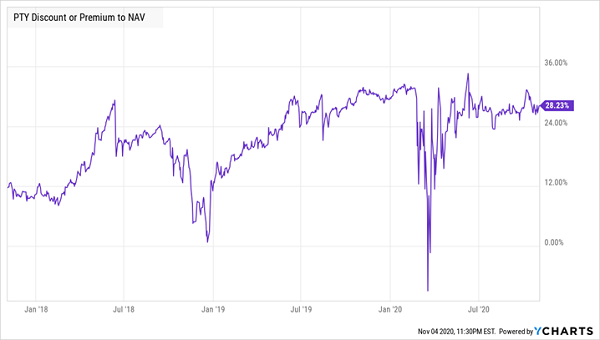
Notice, too, that PTY traded for less than the NAV of its portfolio in March. While that was rare for PTY, it’s common for CEFs. A lot of CEFs trade at discounts (with their market price below their NAV), meaning you can buy their assets for less than what those assets are actually worth.
Then, when the CEF gets more attention and trades at a premium, you can sell for a profit. If the NAV of the portfolio went up, that’s profit twice over. Plus you get to keep all the dividends the CEF has been paying out.
And speaking of dividends, CEFs’ payouts are huge, with the typical CEF yielding 7.4% right now. That’s 4.6 times more than the dividends you get from the S&P 500.
Putting the Pieces Together for a Cheap Tech Buy (and an 8.2% Dividend!)
So, if we can find a CEF that trades at a big discount and pays a nice dividend, we can get a big passive income stream plus today’s tech darlings at yesterday’s prices and the chance for capital gains in the future.
Fortunately, just such a CEF exists. The Columbia Seligman Premium Technology Growth Fund (STK) has a portfolio of tech stalwarts, including Apple, Microsoft (MSFT) and Broadcom (AVGO).
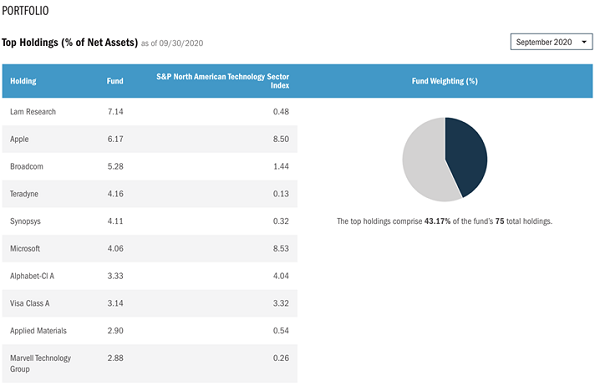
Source: Columbia Seligman
This portfolio is trading at a 2.9% discount to NAV as I write this, meaning you can get in for pretty close to where the tech sector traded before the election. Then you can wait for the fund to trade at a premium, like it did back in June, when its premium rose above 10%.
STK Is on Sale
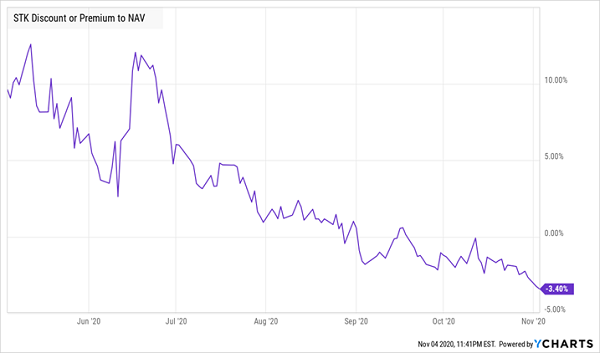
As you can see, the fund’s premium has been chipped away in recent months as worried CEF investors fretted that a tech selloff was due. Then when tech started falling below its 52-week high in September and October, the fund traded at a discount for the first time since April.
That makes it a great buy now, and a great fund to keep—and hold for its rich 8.2% dividend—until that discount reverts back to the premium STK has sported for 90% of the time over the last decade.
My Top 4 CEFs Have 20% Upside, Yield 8.1% (Names Below)
There’s one more thing about this unusual time period we need to remember: that historically speaking, stocks gain ground from Election Day through to the end of the year.
It’s a phenomenon that’s been observed after elections for decades, including in 2016, when stocks dropped just before the vote and then rallied heading into the end of the year.
A 2016 Replay Ahead?
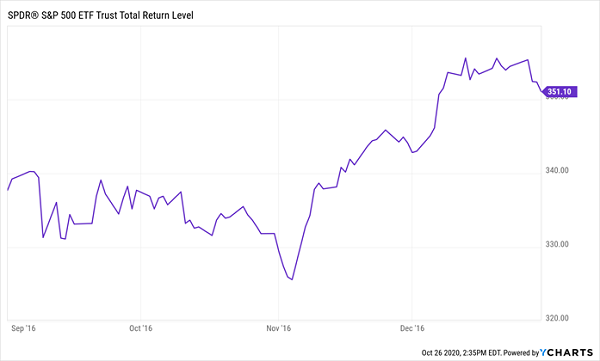
The typical investor would try to profit from this pattern by purchasing an ETF like the SPDR S&P 500 ETF (SPY), the go-to tracker of the main stock index.
But as I just showed you, following that strategy means you never get a discount—and your payouts are pathetic, too! SPY yields just 1.6% as I write this.
This is where my 4 top CEFs to buy now come in. They yield an outsized 8.1%, on average, and they trade at massive discounts—so massive that I’m calling for fast 20%+ upside from each of these 4 dynamic funds.
In other words, you benefit as those huge discounts disappear and you’re set to profit as a rising market pumps up the value of their portfolios, too! That’s a rare double win. And you could make it a triple, thanks to these funds’ huge cash payouts.
Full details on each of these 4 breakthrough funds are waiting for you now. Get their names, tickers, complete dividend histories and everything you need to know about them right now, before their prices take off.
